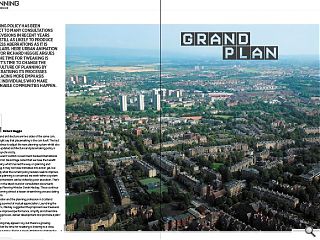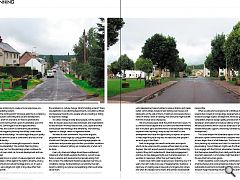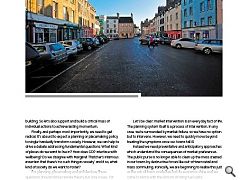Planning Reform
4 Aug 2012
Planning policy has been subject to many consultations and revisions in recent years but is still as likely to produce a soulless abberation as it is an exemplar. Here Urban Animation director Richard Heggie argues that the time for tweaking is over. It's time to change the very culture of planning by democratising its processes and placing more emphasis on the individuals who make sustainable communities happen.
At the recent Scottish Government-backed International Design Summit, David Page noted that we have the benefit of public policy which has led the way on planning and placemaking. It may not have translated into action yet, but that’s largely what the current policy reviews seek to improve.
As far as planning is concerned, we work within a system where good intentions can be stifled by poor execution. That’s recognised in the latest round of consultation documents published by Planning Minister Derek Mackay. These continue what is becoming almost a kaizen streamlining process dating back to 2006.
The Minister and the planning profession in Scotland are enjoying a period of mutual appreciation. Launching the consultations, Mackay suggested the proposed new measures would “drive improved performance, simplify and streamline the planning process, deliver development and promote a plan-led system”.
Everything may appear rosy, but there’s a growing realisation that the time for tweaking is drawing to a close. Beneath the surface, there’s a steely ambition to change the whole culture of planning to create a more responsive, pro-active and enabling system.
What’s the starting point? Obviously planning is a statutory, regulatory system controlling land use and development. But to what end? On one hand, it’s there to promote the Scottish Government’s primary goal of sustainable economic development. Some argue it has the opposite effect.
Meanwhile, the Scottish Government’s placemaking policy agenda suggests planning should help create better places, streets and buildings. Yet some argue that poor quality planning has been the cause of clone towns and loss of local and regional identity.
Is it there to shape a meaningful response to climate change and sustainability? The Scottish Planning Policy document says ‘yes’, but the planning system continues to deliver out-of-town retail, car-focused development and low-density sprawl.
Finally, planning is a system of value judgement, where the right to develop is offset against the right to amenity, privacy, protection of built and cultural heritage and so on. It’s just a shame that we’ve largely lost sight of any value other than economic growth.
We’re back to good intentions and poor execution, hence the emphasis on culture change. What’s holding us back? There are elephants in our planning departments, consultancy offices and developer boardrooms: people who are resisting or failing to respond to change.
So culture change is really about people, not the system. How do we persuade or provoke individuals and organisations to raise the bar? We may need to train, coax, cajole and force some people into thinking a little differently. The following ‘agenda for change’ needs no legislative review.
We need to start somewhere. Any neuro-linguistic programmer would begin by using positive language. We should insist that plans and policy use language people can understand and promote opportunities, possibilities, ambitions and visions, instead of setting out complex lists of what can’t be done.
Every city, town and village should have a settlement statement which briefly explains the history, current issues, future scenarios and development proposals arising from this context. The statement should be adjusted over time, as conditions change. If placemaking is our priority, then let’s begin by defining our places and explaining what we all value about them.
Once we understand the issues, let’s be more creative in using development opportunities to solve problems and create better communities, instead of just sticking new houses and retail parks on the side of towns. If planners and people share a vision of where a town is heading, then everyone might benefit from this mutual sense of purpose.
We should ask people what they think their town needs. It’s a common misconception that our towns are filled with NIMBYs (not in my back yard) and BANANAs (build absolutely nothing anywhere near anything). Many accept the need for new development and value the opportunity to express an opinion or help shape the place they live. We need only fear people if we are trying to fool them.
Back to language. We need to write plans and reports which can be understood by people without planning or law degrees. We can’t expect people to engage with the planning system if they don’t understand it. Meaningful engagement and face-to-face dialogue might even humanise planners - if we listen to responses, rather than just hearing them.
If we’re stuck with a plan review process stretching over 3-5 years, then let’s make more use of Supplementary Guidance - a rapid way of creating responsive policy to target action where and when it’s needed. Some towns and centres would benefit from dedicated Supplementary Guidance to drive change and raise profile.
When we allocate housing land, let’s distribute it between several sites instead of a single large development area. That would encourage organic development, introduce greater competition, improve design quality, provide work for local developers and builders and reduce reliance on big-ticket infrastructure items (which could be advanced or jointly-funded with public support, where they constrain appropriate development).
This could temper the adversarial aspect of our land allocation system where landowners compete voraciously for an ever-larger slice of a half-baked pie. The focus might shift from planning-by-numbers and ‘units’ to town building and placemaking. Council Planners might even find themselves able to re-engage with their former adversaries. Developers could find themselves benefitting from clarity and the ability to take a long-term approach. Communities might feel able to influence the way their home town grows.
Small is beautiful, so let’s value the contribution individuals, small businesses and social enterprises make to delivering sustainable investment and building vibrant communities. The Amazon mega-shed brings much-needed jobs at the expense of quality architecture, placemaking, planning and community building. So let’s also support and build a critical mass of individual actions to achieve lasting momentum.
Finally, and perhaps most importantly, we need to get radical. It’s absurd to expect a planning or placemaking policy to single-handedly transform society. However, we can help to drive a debate addressing fundamental questions. What kind of places do we want to live in? How does GDP interface with wellbeing? Do we disagree with Margaret Thatcher’s infamous assertion that there’s ‘no such thing as society’ and if so, what kind of society do we want to foster?
For planning, placemaking and architecture, those questions should not be remote theory but core issues. For example, we’ve long accepted out-of-town retail and suburban sprawl on the most lucrative and easily developed sites, because the market told us to. As Urban Realm’s Carbuncle Award illustrates, one consequence is the decline of our town centres.
Apparently, the market is now telling us some town centres should be left to die. If the market told us to jump under a bus, would we? The recent success of Cumbernauld in the Urban Realm sponsored Scottish Civic Pride Awards is a timely reminder that people and communities are more important than buildings and free market economic theory.
Let’s be clear: market intervention is an everyday fact of life. The planning system itself is a process of intervention. In any case, we’re surrounded by market failure, so we have no option but to intervene. However, we need to quickly move beyond treating the symptoms once our towns fall ill.
Instead we need preventative and anticipatory approaches which understand the consequences of market preferences. The public purse is no longer able to clean up the mess created in our towns by destructive forces like out-of-town retail and mass commuting. Ironically, we are beginning to realise this just as the out-of-town model has lost its economic shine and we come to terms with the ransom of rising fuel costs.
There is another current Scottish Government consultation we should all respond to: the proposed Community Empowerment and Renewal Bill. Knitting all these strands together with housing, regeneration, health, transport, cities and towns policies is a challenge for the Scottish Government (and the rest of us).
It can only be done through a clear direction of travel for Scottish social, cultural, economic and public policy. We can all play a role in steering change but ultimately, the planning, architecture and places we get will reflect the society we live in. That’s perhaps where culture change should start.
|
|
Read next: Making
Read previous: George Clarke
Back to August 2012
Browse Features Archive
Search
News
For more news from the industry visit our News section.
Features & Reports
For more information from the industry visit our Features & Reports section.





